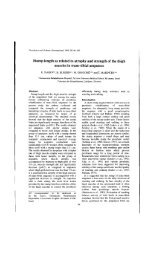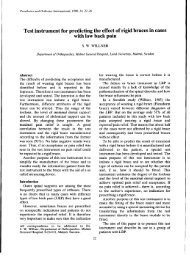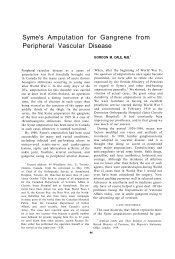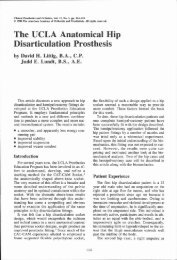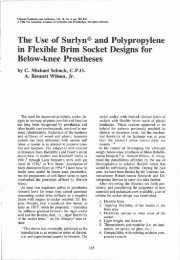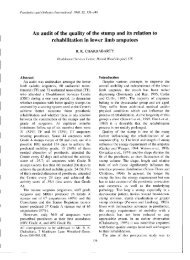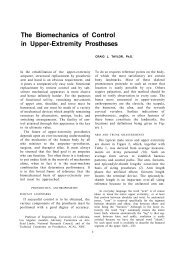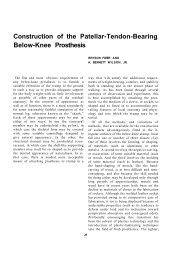Pro-Corn - O&P Library
Pro-Corn - O&P Library
Pro-Corn - O&P Library
Create successful ePaper yourself
Turn your PDF publications into a flip-book with our unique Google optimized e-Paper software.
For bench alignment, the following references<br />
are used:<br />
1. Posteriorly, bisect the socket at the level<br />
of the soft tissue ML, this reference line<br />
should fall as a plumb line to the center of<br />
the heel.<br />
2. Laterally, bisect the socket AP dimension<br />
at ischial level, this reference line should<br />
fall as a plumb line between 0" and 1" anterior<br />
to the foot bolt.<br />
3. Socket is set in measured adduction, and<br />
measured flexion plus 5°.<br />
4. The distal aspect of the medial wall<br />
should be on the line of progression.<br />
5. The knee bolt is externally rotated 5°.<br />
6. The top of the foot, as well as the prosthetic<br />
shank should lean medially 4°, or<br />
alternatively, the socket is hyper-adducted<br />
4° beyond measured adduction<br />
with the foot parallel to the floor and the<br />
shank perpendicular to the floor.<br />
The UCLA CAT-CAM can be fabricated<br />
using rigid socket or flexible socket techniques.<br />
If a flexible socket or brim system is desired,<br />
the proximal medial trimline in the ischial area<br />
must be more aggressive during casting to<br />
allow for the linear shrinkage factor known in<br />
most thermoplastics.<br />
A final comment: the manual reflects the accumulated<br />
experience of the UCLA staff and<br />
includes a section on problem solving the difficulties<br />
that might be experienced in the CAT-<br />
CAM socket.<br />
Next to speak was Gunther Gehl, CP., Director<br />
of <strong>Pro</strong>sthetic Education at Northwestern<br />
University in Chicago. Northwestern has been<br />
teaching the NSNA AK techniques of Ivan<br />
Long for several years now, and it was Mr.<br />
Gehl's task to report to the workshop on NSNA<br />
and Long's Line. He said that he and his staff<br />
taught NSNA as presented by Ivan Long with<br />
no changes. Ivan has been fitting Long's Line,<br />
now known as NSNA, for more than 12 years,<br />
and his approach has been consistent, with few<br />
changes. Perhaps changing the name from<br />
Long's Line to NSNA in July, 1985 is the most<br />
significant change. Mr. Long has published<br />
three technical papers describing his technique:<br />
"Allowing Normal Adduction of the Femur in<br />
Above Knee Amputees," {Orthotics and <strong>Pro</strong>sthetics,<br />
December, 1975); "Fabricating the<br />
Long's Line Above Knee <strong>Pro</strong>sthesis," (1981);<br />
and as a reprint of the Long's Line article with<br />
new title, "Normal Shape-Normal Alignment<br />
(NSNA) Above Knee <strong>Pro</strong>sthesis," (Clinical<br />
<strong>Pro</strong>sthetics and Orthotics, Fall, 1985). These<br />
articles were the basis for Gunther Gehl's presentation<br />
to the International Workshop.<br />
I will attempt to review and highlight the<br />
NSNA philosophy as I did the UCLA CAT-<br />
CAM. Again, within the limitations of this report,<br />
this will only be an overview. With the<br />
widespread availability of Ivan's publications,<br />
it does not seem necessary to go into details.<br />
NSNA is less detailed regarding evaluation<br />
and measurements, placing great emphasis on<br />
the wrap cast, subsequent model modification,<br />
and alignment, all based on Long's Line,<br />
which is defined as a straight line, starting approximately<br />
at the center of a narrow socket,<br />
passing through the distal femur, and on down<br />
to the center of the heel (Figure 7). Long's Line<br />
is not always vertical because it shifts constantly<br />
when the amputee goes from a standing<br />
position to a walking position.<br />
The wrap cast is taken with the patient in a<br />
standing position. The important points about<br />
the wrap cast procedure are identification of the<br />
ischium and proper alignment. The hand will<br />
be held to indicate the medial and posterior surface<br />
of the ischium, but not forward of the ischium.<br />
The amputee then adducts as tightly as<br />
possible and extends his thigh to tighten the<br />
hamstrings. At this point a lateral reference line<br />
is established.<br />
The resultant cast model is oversized and<br />
will require considerable modification. Practically<br />
all modification will take place on the lateral<br />
wall. Following is a brief description of<br />
modification goals and resultant trimlines,<br />
taken from Mr. Gehl's presentation and from<br />
Mr. Long's publications.<br />
1. The lateral wall is to be shaped to give<br />
support over a wide area, and particularly<br />
the lateral-posterior aspect of the socket.<br />
2. The medial wall will be lower than seat<br />
level, and the wrap cast will be the guideline<br />
as to how low.<br />
3. Depth of the socket will be the same as<br />
the measured length of the thigh.<br />
4. The seat will be at a right angle to Long's<br />
Line.<br />
5. Long's Line is drawn from the center of



